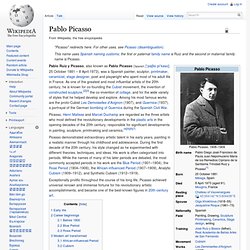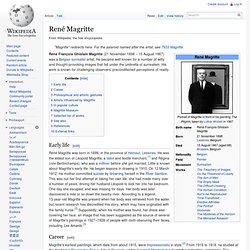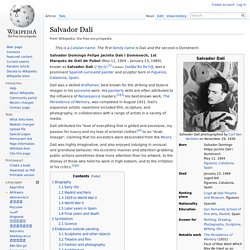

Pablo Picasso. Picasso, Henri Matisse and Marcel Duchamp are regarded as the three artists who most defined the revolutionary developments in the plastic arts in the opening decades of the 20th century, responsible for significant developments in painting, sculpture, printmaking and ceramics.[4][5][6][7] Picasso demonstrated extraordinary artistic talent in his early years, painting in a realistic manner through his childhood and adolescence.

During the first decade of the 20th century, his style changed as he experimented with different theories, techniques, and ideas. His work is often categorised into periods. While the names of many of his later periods are debated, the most commonly accepted periods in his work are the Blue Period (1901–1904), the Rose Period (1904–1906), the African-influenced Period (1907–1909), Analytic Cubism (1909–1912), and Synthetic Cubism (1912–1919). Early life Pablo Picasso and his sister Lola, c.1889 Picasso showed a passion and a skill for drawing from an early age. Fame. René Magritte. René François Ghislain Magritte (21 November 1898 – 15 August 1967) was a Belgian surrealist artist.

He became well known for a number of witty and thought-provoking images that fall under the umbrella of surrealism. His work is known for challenging observers' preconditioned perceptions of reality. Early life[edit] Career[edit] Magritte's earliest paintings, which date from about 1915, were Impressionistic in style.[2] From 1916 to 1918, he studied at the Académie Royale des Beaux-Arts in Brussels, under Constant Montald, but found the instruction uninspiring. In 1922, Magritte married Georgette Berger, whom he had met as a child in 1913.[1] From December 1920 until September 1921, Magritte served in the Belgian infantry in the Flemish town of Beverlo near Leopoldsburg. Galerie 'Le Centaure' closed at the end of 1929, ending Magritte's contract income. During the German occupation of Belgium in World War II he remained in Brussels, which led to a break with Breton. Salvador Dalí. Salvador Domingo Felipe Jacinto Dalí i Domènech, 1st Marqués de Dalí de Pubol (May 11, 1904 – January 23, 1989), known as Salvador Dalí (/ˈdɑːli/;[1] Catalan: [səɫβəˈðo ðəˈɫi]), was a prominent Spanish surrealist painter and sculptor born in Figueres, Catalonia, Spain.

Dalí was a skilled draftsman, best known for the striking and bizarre images in his surrealist work. His painterly skills are often attributed to the influence of Renaissance masters.[2][3] His best-known work, The Persistence of Memory, was completed in August 1931. Dalí's expansive artistic repertoire included film, sculpture, and photography, in collaboration with a range of artists in a variety of media. Dalí attributed his "love of everything that is gilded and excessive, my passion for luxury and my love of oriental clothes"[4] to an "Arab lineage", claiming that his ancestors were descended from the Moors. Dalí was highly imaginative, and also enjoyed indulging in unusual and grandiose behavior. Maurizio Cattelan. Maurizio Cattelan (September 21, 1960, Padova, Italy) is an Italian artist. He is known for his satirical sculptures, particularly La Nona Ora (The Ninth Hour), depicting the Pope John Paul II struck down by a meteorite.
Early life[edit] Cattelan started his career in Forlì (Italy) making wooden furniture in the 1980s where he came to know some designers like Ettore Sottsass. He made a catalogue of his work which he sent to galleries. This promotion gave him an opening in design and contemporary art. Artistic style[edit] Cattelan’s personal art practice has led to him gaining a reputation as an art scene’s joker.[1] In 1995 he began his line of taxidermied horses, donkeys, mice and dogs; in 1999 he started making life-size wax effigies of various people, including himself.[2] One of his best known sculptures, ‘La Nona Ora’ consists of an effigy of Pope John Paul II in full ceremonial dress being crushed by a meteor and is a good example of his typically humorous approach to work. Ralph Steadman. Ralph Steadman (born 15 May 1936) is a British cartoonist best known for his work with American author Hunter S.

Thompson.[1] Personal life[edit] Steadman currently lives with his wife in Kent, England. Career[edit] Steadman is renowned for his political and social caricatures, cartoons and picture books. Steadman had a long partnership with the American journalist Hunter S. As well as writing and illustrating his own books and Thompson's, Steadman has worked with writers including Ted Hughes, Adrian Mitchell and Brian Patten, and also illustrated editions of Alice in Wonderland, Treasure Island, Animal Farm, the English translation of Flann O'Brien's Gaelic-language classic The Poor Mouth, and most recently, Fahrenheit 451. Among the British public, Steadman is well known for his illustrations for the catalogues of the off-licence chain Oddbins and he designed a set of four British postage stamps to commemorate the appearance of Halley's Comet in 1985. Partial bibliography[edit]